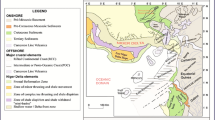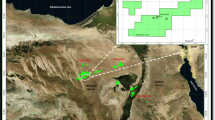Abstract
Geomechanical characterisation of a hydrocarbon reservoir has multifold implications throughout the lifecycle of an oil and gas field, starting from exploration through development to abandon stage. At each phase, geomechanics, its related challenges and complications are different, and thus the perspective of the solution. To provide a practical and reasonable answer, it is imperative to have a robust well based 1D geomechanical model in the first place. This work made an effort to construct a geomechanical model based on well log data, geological information, and drilling-related events in the Hugin Formation of the Volve field in the central part of the North Sea basin. The geomechanical model indicates a strike-slip fault regime (SHmax > Sv > Shmin) in the reservoir section. Vertical stress (Sv) gradient was estimated at 17 ppg (~ 77 MPa) in the reservoir section. Pore pressure profile shows variation along the stratigraphic sequence, and the maximum pressure gradient appeared was approximately 11–11.66 ppg (~ 30–34 MPa) in Skade Formation and 9.61 ppg (~ 33–36 MPa) in Hugin Formation. Within the reservoir intervals, uniaxial compressive strength ranges around 33–39 MPa, Young's modulus (E) at 15–18 GPa, Poisson's ratio (\(\nu\)) at 0.2–0.4 and internal friction at around 0.6 are observed. Based on previous references, the net maximum horizontal stress orientation appears to be approximately E–W. The study indicates mud weight used in Hugin Formation to drill is more than sufficient for wellbore stability. Mud weight estimation for various well trajectories was also analysed. The proposed base model for Hugin Formation of theta vest structure shall help plan future field development strategies and feasibility considerations for possible CO2 sequestration.
Article highlights
-
An investigation has been performed to understand the geomechanical properties and optimum orientation of drilling in the Hugin Formation.
-
Pore pressure data calibrated with direct pressure measurement, and the gradient shows higher than hydrostatic pressure, ~9.61 ppg.
-
The stress state indicates a strong strike-slip fault regime within the Hugin Formation.
-
Rock mechanical properties were calibrated with available core test data, and UCS values range from 31–41 MPa.













Similar content being viewed by others
References
Altmann JB, Müller TM, Müller BIR, Tingay MRP, Heidbach O (2010) Poroelastic contribution to the reservoir stress path. Int J Rock Mech Min Sci 47:1104–1113. https://doi.org/10.1016/j.ijrmms.2010.08.001
Athy LF (1930) Density, porosity, and compaction of sedimentary rocks. Am Assoc Pet Geol Bull 14:1–24
Azim SA, Mukherjee P, Al-Anezi SA, Al-Otaibi B, Al-Saad B, Perumalla S, Araujo E, Babbington JF (2011) Using integrated geomechanical study to resolve expensive wellbore instability problems while drilling through Zubair shale/sand sequence of Kuwait: a case study. In: Proceedings of the SPE/IADC middle east drilling technology conference and exhibition, pp. 1–14. https://doi.org/10.2118/148049-ms
Baouche R, Sen S, Boutaleb K (2020) Present day In-situ stress magnitude and orientation of horizontal stress components in the eastern Illizi basin, Algeria: a geomechanical modeling. J Struct Geol 132:103975. https://doi.org/10.1016/j.jsg.2019.103975
Barton N (1987) Predicting the behaviour of underground openings in jointed rock. In: 4th Manual rocha memorial lecture, Lisbon
Barton CA, Zoback MD, Burns KL (1988) In-situ stress orientation and magnitude at the Fenton Geothermal Site, New Mexico, determined from wellbore breakouts. Geophys Res Lett 15:467–470. https://doi.org/10.1029/GL015i005p00467
Biot MA (1941) General theory of three-dimensional consolidation. J Appl Phys 12:155–164
Biot MA, Willis DG (1957) The elastic coefficients of the theory of consolidation. J Appl Mech 24:594–601
Bowers GL (1995) Pore pressure estimation from velocity data: accounting for overpressure mechanisms besides undercompaction. Soc Pet Eng SPE 27488:89–95
Chadwick RA, Eiken O (2013) Offshore CO2 storage: sleipner natural gas field beneath the North Sea. In: Geological storage of carbon dioxide (CO2): geoscience, technologies, environmental aspects and legal frameworks. Woodhead Publishing Limited, pp. 227–250. https://doi.org/10.1533/9780857097279.3.227
Chamwudhiprecha N, Blunt MJ (2012) Carbon dioxide storage potential in the North Sea. In: International petroleum technology conference, pp. 808–821
Eaton BA (1972) The effect of overburden stress on geopressure prediction from well logs. J Pet Technol 24:929–934. https://doi.org/10.2118/3719-pa
Eaton BA (1975) The equation for geopressure prediction from well logs. In: Fall Meeting of the society of petroleum engineers of AIME. Society of Petroleum Engineers (SPE), Dallas. https://doi.org/10.2118/5544-ms
Eberhardt E (2012) The Hoek–Brown failure criterion. Rock Mech Rock Eng 45:981–988. https://doi.org/10.1007/s00603-012-0276-4
Ewy RT (1999) Wellbore-stability predictions by use of a modified lade criterion. SPE Drill Complet 14:85–91. https://doi.org/10.2118/56862-PA
Færseth RB (1996) Interaction of Permo-Triassic and Jurassic extensional fault-blocks during the development of the northern North Sea. J Geol Soc Lond 153:931–944. https://doi.org/10.1144/GSJGS.153.6.0931
Fang Z, Khaksar A (2012) Geomechanical issues and solutions for CO2 sequestration in depleted hydrocarbon sandstone reservoirs. In: 46th US Rock mechanics/geomechanics symposium, pp 2286–2301
Gale J (2004) Geological storage of CO2: what do we know, where are the gaps and what more needs to be done ? Energy 29:1329–1338. https://doi.org/10.1016/j.energy.2004.03.068
Gardner GHF, Gardner LW, Gregory AR (1974) Formation velocity and density - the diagnostic basics for stratigraphic traps. Geophysics 39:770–780
Ghazvinian AH, Fathi A, Moradian ZA (2008) Failure behavior of marlstone under triaxial compression. Int J Rock Mech Min Sci 45:807–814. https://doi.org/10.1016/j.ijrmms.2007.09.006
Grollimund B, Zoback MD (2003) Impact of glacially induced stress changes on fault-seal integrity offshore Norway. Am Assoc Pet Geol Bull 87:493–506. https://doi.org/10.1306/09070404063
Heidbach O, Tingay M, Barth A, Reinecker J, Kurfeß D, Müller B (2010) Global crustal stress pattern based on the World Stress Map database release 2008. Tectonophysics 482:3–15. https://doi.org/10.1016/j.tecto.2009.07.023
Heidbach O, Rajabi M, Cui X, Fuchs K, Müller B, Reinecker J, Reiter K, Tingay M, Wenzel F, Xie F, Ziegler MO, Zoback ML, Zoback M (2018) The world stress map database release 2016: crustal stress pattern across scales. Tectonophysics 744:484–498. https://doi.org/10.1016/j.tecto.2018.07.007
Hillis RR, Nelson EJ (2005) In situ stresses in the North Sea and their pplications: petroleum geomechanics from exploration to development. Geol Soc Lond Pet Geo Conf Ser 6:551–564
Hoek E, Brown ET (1980) Emperical strength criterion for rock masses. J Geotech Eng Div 106(GT9):1013–1035
Hottman CE, Johnson RK (1965) Estimation of formation pressures from log-derived shale properties. In: SPWLA 6th annual logging symposium, society of petrophysicists and well-log analysts, Dallas
Justwan H (2006) The petroleum systems of the South Viking Graben. University of Bergen, Norway. https://doi.org/10.1036/13431857M106298
Khaksar A, Taylor PG, Fang Z, Kayes T, Salazar A, Rahman K (2009) Rock strength from core and logs: where we stand and ways to go. In: Society of petroleum engineers—EUROPEC/EAGE Conference and Exhibition, Amsterdam, pp 8–11
Labuz JF, Zang A (2012) Mohr–Coulomb failure criterion. Rock Mech Rock Eng 45:975–979. https://doi.org/10.1007/s00603-012-0281-7
Lade PV (1977) Elasto-plastic stress-strain theory for cohesionless soil with curved yield surfaces. Int J Solids Struct 13:1019–1035. https://doi.org/10.1016/0020-7683(77)90073-7
Nicot J (2008) Evaluation of large-scale CO2 storage on fresh-water sections of aquifers: an example from the Texas Gulf Coast Basin. Int J Greenh Gas Control 2:582–593. https://doi.org/10.1016/j.ijggc.2008.03.004
Osagiede EE, Rotevatn A, Gawthorpe R, Kristensen TB, Jackson CAL, Marsh N (2020) Pre-existing intra-basement shear zones influence growth and geometry of non-colinear normal faults, western Utsira high-heimdal terrace. North Sea J Struct Geol 130:103908. https://doi.org/10.1016/j.jsg.2019.103908
Pariseau WG (2007) Fitting failure criteria to laboratory strength tests. Int J Rock Mech Min Sci 44:637–646. https://doi.org/10.1016/j.ijrmms.2006.09.006
Reinecker J, Tingay M, Müller B (2003) Borehole breakout analysis from four-arm caliper logs. World Stress Map Proj, pp 1–5
Shukla R, Ranjith P, Haque A, Choi X (2010) A review of studies on CO2 sequestration and caprock integrity. Fuel 89:2651–2664. https://doi.org/10.1016/j.fuel.2010.05.012
Statoil (1993) Discovery evaluation report. Well 15/9-19SR, Theta Vest Structure-PL046A
Tenzer R, Gladkikh V (2014) Assessment of density variations of marine sediments with ocean and sediment depths. Sci World J. https://doi.org/10.1155/2014/823296
Traugott M (1997) Porepressure and fracture pressure determinations in deepwater. In: Pipe line and gas industry, pp 68–70
Vishal V (2017a) In-situ disposal of CO2: liquid and supercritical CO2 permeability in coal at multiple down-hole stress conditions. J CO2 Util 17:235–242. https://doi.org/10.1016/j.jcou.2016.12.011
Vishal V (2017b) Saturation time dependency of liquid and supercritical CO2 permeability of bituminous coals: implications for carbon storage. Fuel 192:201–207. https://doi.org/10.1016/j.fuel.2016.12.017
Vishal V, Ranjith PG, Pradhan SP, Singh TN (2013a) Permeability of sub-critical carbon dioxide in naturally fractured Indian bituminous coal at a range of down-hole stress conditions. Eng Geol 167:148–156. https://doi.org/10.1016/j.enggeo.2013.10.007
Vishal V, Ranjith PG, Singh TN (2013b) CO2 permeability of Indian bituminous coals: implications for carbon sequestration. Int J Coal Geol 105:36–47. https://doi.org/10.1016/j.coal.2012.11.003
Vishal V, Singh TN, Ranjith PG (2015) Influence of sorption time in CO2-ECBM process in Indian coals using coupled numerical simulation. Fuel 139:51–58. https://doi.org/10.1016/j.fuel.2014.08.009
Vishal V, Mahanta B, Pradhan SP, Singh TN, Ranjith PG (2018) Simulation of CO2 enhanced coalbed methane recovery in Jharia coalfields, India. Energy 159:1185–1194. https://doi.org/10.1016/j.energy.2018.06.104
Wiprut D (2001) Stress, borehole stability and hydrocarbon leakage in the Northern North Sea. Stanford University, Stanford
Wiprut D, Zoback M (2000) Constraining the stress tensor in the Visund feld, Norwegian North Sea Application.pdf. Int J Rock Mech Min Sci 37:317–336
York P, Prichard D, Dodson J, Dodson T, Rosenberg S, Gala D, Utama B (2009) Eliminating non-productive time associated with drilling trouble zones. In: Offshore technology conference, Houston, pp 1–18. https://doi.org/10.4043/otc-20220-ms
Zhang J (2011) Pore pressure prediction from well logs: methods, modifications, and new approaches. Earth Sci Rev 108:50–63. https://doi.org/10.1016/j.earscirev.2011.06.001
Zhang J (2019) In situ stress estimate. In: Applied petroleum geomechanics, pp 187–232. https://doi.org/10.1016/b978-0-12-814814-3.00006-x
Zhang J, Yin SX (2017) Fracture gradient prediction: an overview and an improved method. Pet Sci 14:720–730. https://doi.org/10.1007/s12182-017-0182-1
Zhao J (2000) Applicability of Mohr–Coulomb and Hoek–Brown strength criteria to the dynamic strength of brittle rock. Int J Rock Mech Min Sci 37:1115–1121. https://doi.org/10.1016/S1365-1609(00)00049-6
Zoback MD (2007) Reservoir geomechanics, reservoir geomechanics. Cambridge University Press, Cambridge. https://doi.org/10.1017/CBO9780511586477
Zoback ML, Zoback MD (1989) Tectonic stress field of the continental United States. In: Pakiser LC, Mooney WD (eds) Geophysical framework of the continental United States: Boulder, Colorado, Geological Society of America Memoir 172, pp 523–539. https://doi.org/10.1130/MEM172-p523
Zoback MD, Barton CA, Brudy M, Castillo DA, Finkbeiner T, Grollimund BR, Moos DB, Peska P, Ward CD, Wiprut DJ (2003) Determination of stress orientation and magnitude in deep wells. Int J Rock Mech Min Sci 40:1049–1076. https://doi.org/10.1016/j.ijrmms.2003.07.001
Acknowledgements
The authors would like to express their sincere gratitude to the Baker Hughes geomechanics team for their suggestions during this work.
Author information
Authors and Affiliations
Corresponding author
Ethics declarations
Conflict of interest
We do not have any commercial or associative interest representing a conflict of interest with the submitted work.
Additional information
Publisher's Note
Springer Nature remains neutral with regard to jurisdictional claims in published maps and institutional affiliations.
Rights and permissions
About this article
Cite this article
Saha, S., Vishal, V., Mahanta, B. et al. Geomechanical model construction to resolve field stress profile and reservoir rock properties of Jurassic Hugin Formation, Volve field, North Sea. Geomech. Geophys. Geo-energ. Geo-resour. 8, 68 (2022). https://doi.org/10.1007/s40948-022-00359-5
Received:
Accepted:
Published:
DOI: https://doi.org/10.1007/s40948-022-00359-5




